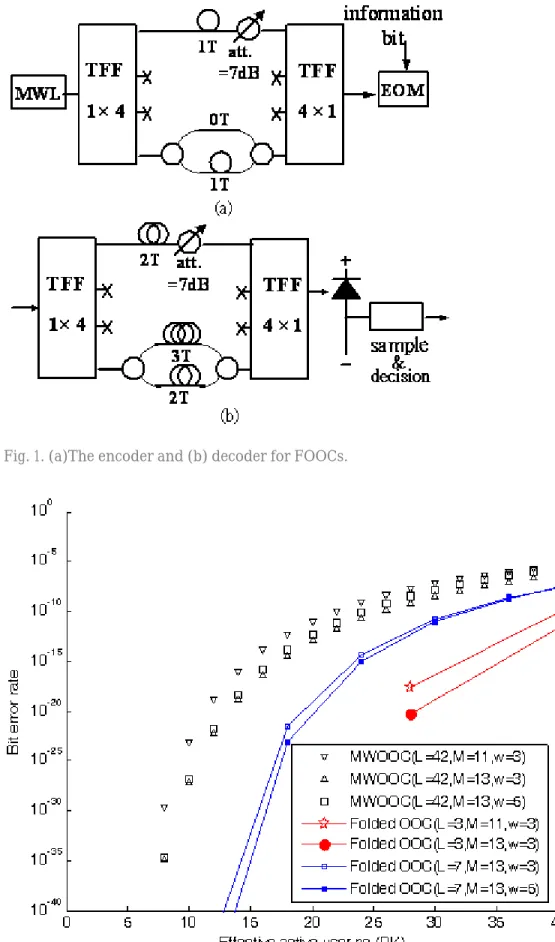Research Express@NCKU - Articles Digest
Research Express@NCKU Volume 5 Issue 9 - September 26, 2008 [ http://research.ncku.edu.tw/re/articles/e/20080926/3.html ]
On the design and performance analysis of wavelength/time matrix coding for optical CDMA network access
Jen Fa Huang1*, Chao Chin Yang2
1Dept. of Electrical Engineering, National Cheng Kung University, Professor
2Dept. of Electronic Engineering, Kun Shan University, Assistant Professor
1 huajf@ee.ncku.edu.tw; 2 ccyang@mail.ksu.edu.tw
● Chao-Chin Yang, Jen-Fa Huang, and Yi-Hseng Wang, “Comments on ‘Design and
Performance Analysis of Waveguide/Time (W/T) Matrix Codes for Optical CDMA’,” IEEE J.
Lightwave Technology, vol. 25, no. 10, p. 3210, October 2007.
● Chao-Chin Yang, Jen-Fa Huang, and Yi-Hseng Wang, “Multipulse-Per-Row Codes for High
Speed Optical Wavelength/Time CDMA Networks,” IEEE Photonics Technology Letters, vol.
19, no. 21, pp. 1756-1758, November 2007.
Code division multiple access (CDMA) techniques were investigated for optical network applications during the last 20 to 25 years. These techniques have advantages that many users are allowed to access the common channel asynchronously and securely, and high statistical multiplexing gain can be offered even in bursty traffic since dedicated time or wavelength slots do not have to be allocated. These characteristics distinguish CDMA from other multiplexing schemes such as time- division multiple-access (TDMA) and
wavelength-division multiple-access (WDMA). Among the various optical CDMA schemes, the most famous one is the incoherent time-spreading optical CDMA scheme and the corresponding
implementation is relatively simple. In this kind of optical CDMA scheme, since each transmitted information bit is replaced by N codeword chips, the reduction of bit rate may be serious when the code length is long. Due to the use of unipolar optical signals, the original one-dimensional (1-D) optical orthogonal codes are always very long to reduce multiple access interference (MAI) and increase the code cardinality. Though two-dimensional (2-D) codes that combine time-spreading and wavelength- hopping techniques could partially alleviate these problems, codes with shorter lengths than that of previous codes should be developed to avoid reductions of bit rate, which is a crucial factor in the high- speed transmission.
Though the 2-D codes with short lengths were constructed in Mendez’s paper by folding the unipolar sequences from the Golomb rulers with zero padding, these codes failed to achieve ideal correlation properties. Therefore, we proposed one 2-D code family named folded optical orthogonal codes (FOOCs) to alleviate the code length problem mentioned above. These FOOCs can be easily constructed by folding the existing 1-D OOCs with suitable correlation property. Thus code construction can be achieved
without additional efforts for codeword searching, and the constructed codewords have ideal correlation properties and optimal cardinalities. For example, two OOCs with length 16 are listed as follows:
C0 = [1 1 0 0 1 0 0 0 0 0 0 0 0 0 0 0]
1 of 4
Research Express@NCKU - Articles Digest
and
C1 = [1 0 1 0 0 0 0 1 0 0 0 0 0 0 0 0],
respectively. By folding these two OOCs in a column-wise manner and shifting the resulting 2-D matrices, the following eight 4×4 2-D code matrices can be obtained:
By examining all cases for codeword shifting, it can be found that all cases for the auto-correlations and cross-correlations in one 1-D code family can be mapped one-to-one to that of the corresponding 2-D code family. Since each cyclic shifting version of C0 have no more than one “1” chips in collision with that of C1, it can be obtained immediately that the corresponding 2-D FOOC codewords have no more than one “1” chips in collision and the corresponding out-of-phase auto-correlation (or cross-correlation) is no more than one. Thus FOOC is said to have ideal correlation properties. Note that the cardinality of the FOOCs is optimal according to Johnson bound.
The encoder used to generate the 4×4 FOOCs A0,3 is shown in Fig. 1(a). This encoder uses one multiple wavelength laser (MWL) as a light source, one electrical-optical modulator(EOM) as a modulator, and two 1×4 thin film filter(TFF) for demultiplex/multiplex the wavelengths emitted by MWL. The number of delay lines (DL) connected to each output port of the TFF depends on the number of “1” chips at the corresponding row of the FOOC. The decoder complementing the encoder mentioned above is shown in Fig. 1(b) and the main part of the decoder is the same as that of the encoder in Fig. 1(a), except that the time delays of the DLs in the decoder should be “complement” to that of the corresponding encoder.
2 of 4
Research Express@NCKU - Articles Digest
Fig. 1. (a)The encoder and (b) decoder for FOOCs.
Fig. 2. BER v.s. Effective active user no.
The results of bit error rate (BER) comparison are shown in Fig. 2. Here the code family MWOOC is chosen for comparison since this code family was also proposed for the reduction of code lengths. Since the code lengths of FOOCs are shorter than MWOOCs, it is fair to use the effective active user number RK instead of number of active users K for performance comparison, where R is the ratio of the code
3 of 4
Research Express@NCKU - Articles Digest
lengths of the MWOOCs to that of the FOCCs in discussion. For the same BERs, RK values of FOOCs are always larger than that of MWOOCs. Thus FOOCs obtain better spectral efficiencies than other 2-D codes.
Therefore, the proposed 2-D codes have the advantages of better spectral efficiency, ideal correlation properties, flexible code length and optimal cardinality. In addition, they are suitable for the application of secure optical communications due to their irregular code patterns.
4 of 4
